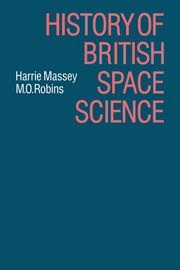Book contents
- Frontmatter
- Contents
- Glossary of abbreviations in text and annexes
- Glossary of abbreviations in appendices
- Preface
- 1 The scientific background
- 2 The technical background
- 3 The initiation of the Skylark rocket programme – the IGY and artificial satellites
- 4 Post-IGY developments – NASA – COSPAR – British National Committee for Space Research – British satellite experiments
- 5 The Ariel programme
- 6 The European Space Research Organization
- 7 Commonwealth co-operation in space reseach
- 8 Smaller rockets for scientific purposes – Skua and Petrel
- 9 Attitude controlled Skylark rockets
- 10 The Trend Committee and the Science Research Council
- 11 The transformation of ESRO into ESA
- 12 The Space Science Committee for Europe
- 13 Scientific studies by British space scientists – figure of the earth and the neutral atmosphere
- 14 Scientific studies by British space scientists – the ionosphere, the magnetosphere and cosmic rays
- 15 The contribution from British space scientists to astronomy
- 16 Concluding remarks
- Appendices
- Annexes
- Notes
- Index
9 - Attitude controlled Skylark rockets
Published online by Cambridge University Press: 05 February 2012
- Frontmatter
- Contents
- Glossary of abbreviations in text and annexes
- Glossary of abbreviations in appendices
- Preface
- 1 The scientific background
- 2 The technical background
- 3 The initiation of the Skylark rocket programme – the IGY and artificial satellites
- 4 Post-IGY developments – NASA – COSPAR – British National Committee for Space Research – British satellite experiments
- 5 The Ariel programme
- 6 The European Space Research Organization
- 7 Commonwealth co-operation in space reseach
- 8 Smaller rockets for scientific purposes – Skua and Petrel
- 9 Attitude controlled Skylark rockets
- 10 The Trend Committee and the Science Research Council
- 11 The transformation of ESRO into ESA
- 12 The Space Science Committee for Europe
- 13 Scientific studies by British space scientists – figure of the earth and the neutral atmosphere
- 14 Scientific studies by British space scientists – the ionosphere, the magnetosphere and cosmic rays
- 15 The contribution from British space scientists to astronomy
- 16 Concluding remarks
- Appendices
- Annexes
- Notes
- Index
Summary
The scientific case
We have described in Chapter 3 the genesis of the Skylark programme, and the development of the rocket into a reliable and versatile vehicle for space science experiments requiring a duration of a few minutes at altitudes up to a few hundred kilometres. Here we follow in more detail one important technological development, that of attitude stabilization of the rocket head. This transformed the vehicle from a mere carrier of equipment to high altitudes, to a sophisticated facility enabling astronomical instruments such as spectrometers in the ultra-violet, and X-ray detectors, to be aligned accurately on the sun and on selected stars. Attitude controlled Skylark became the forerunner of the astronomical satellites Ariel 5, Ariel 6, and The International Ultra-violet Explorer (IUE).
On 21 April 1955, when it was clear that a scientific programme using the high altitude rocket being developed by RAE Farnborough would indeed become a reality, a group of interested scientists met informally in Massey's room at University College London (UCL). In addition to Massey and R.L.F. Boyd of UCL, the group included J. Sayers of Birmingham University, D.R. Bates of Queen's University, Belfast, and W.J.G. Beynon of The University College of Wales, Aberystwyth. Possible experiments were discussed in relation to the expected performance of the rocket. It was decided that RAE should be asked to provide, if possible, either telemetry of the angular aspect of the rocket axis during flight, or preferably stabilization of the aspect ‘by means of a large gyro having its axis along that of the vehicle’.
- Type
- Chapter
- Information
- History of British Space Science , pp. 192 - 209Publisher: Cambridge University PressPrint publication year: 1986



